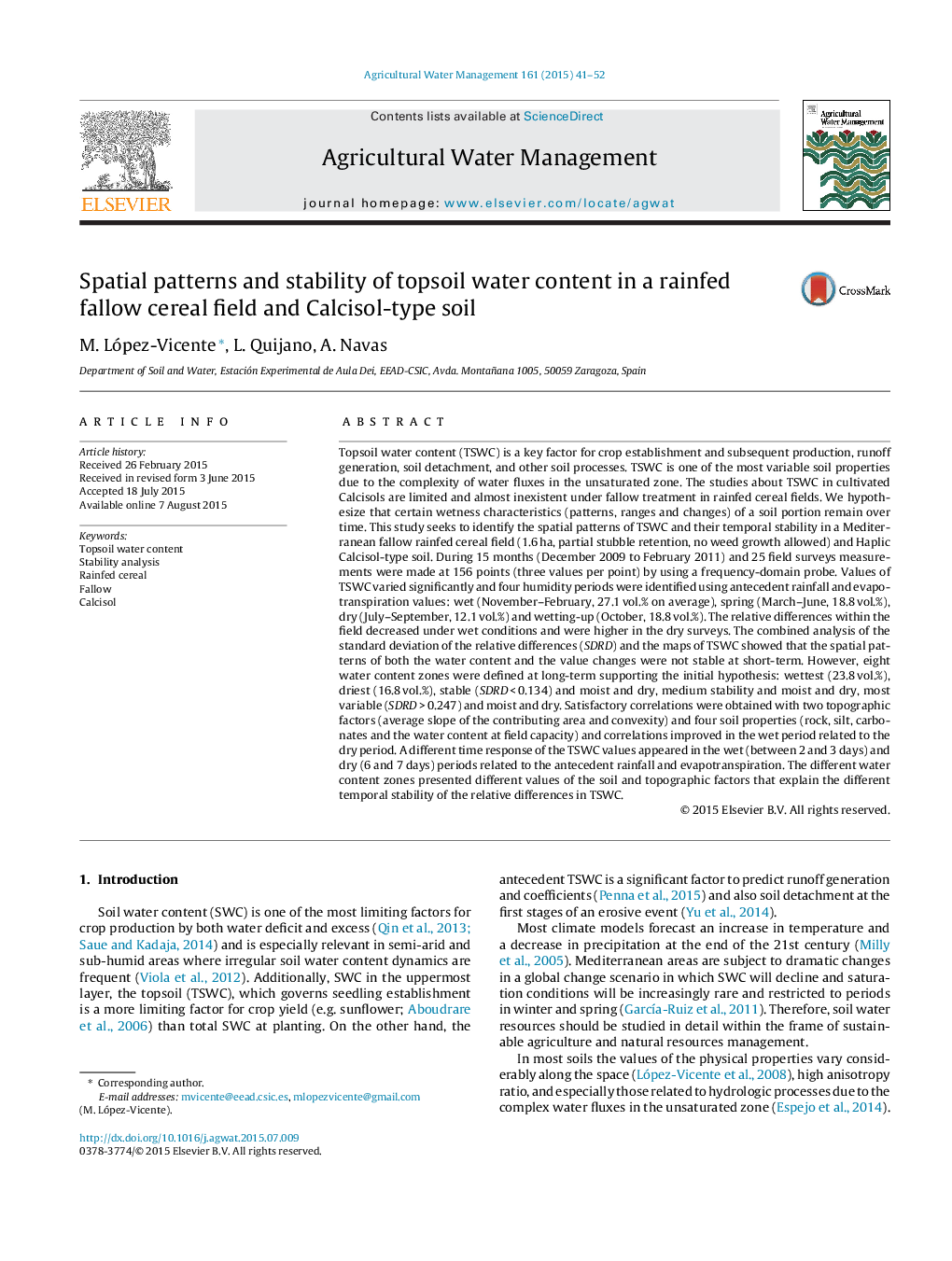| کد مقاله | کد نشریه | سال انتشار | مقاله انگلیسی | نسخه تمام متن |
|---|---|---|---|---|
| 6363606 | 1622918 | 2015 | 12 صفحه PDF | دانلود رایگان |
عنوان انگلیسی مقاله ISI
Spatial patterns and stability of topsoil water content in a rainfed fallow cereal field and Calcisol-type soil
دانلود مقاله + سفارش ترجمه
دانلود مقاله ISI انگلیسی
رایگان برای ایرانیان
موضوعات مرتبط
علوم زیستی و بیوفناوری
علوم کشاورزی و بیولوژیک
علوم زراعت و اصلاح نباتات
پیش نمایش صفحه اول مقاله

چکیده انگلیسی
Topsoil water content (TSWC) is a key factor for crop establishment and subsequent production, runoff generation, soil detachment, and other soil processes. TSWC is one of the most variable soil properties due to the complexity of water fluxes in the unsaturated zone. The studies about TSWC in cultivated Calcisols are limited and almost inexistent under fallow treatment in rainfed cereal fields. We hypothesize that certain wetness characteristics (patterns, ranges and changes) of a soil portion remain over time. This study seeks to identify the spatial patterns of TSWC and their temporal stability in a Mediterranean fallow rainfed cereal field (1.6Â ha, partial stubble retention, no weed growth allowed) and Haplic Calcisol-type soil. During 15 months (December 2009 to February 2011) and 25 field surveys measurements were made at 156 points (three values per point) by using a frequency-domain probe. Values of TSWC varied significantly and four humidity periods were identified using antecedent rainfall and evapotranspiration values: wet (November-February, 27.1Â vol.% on average), spring (March-June, 18.8Â vol.%), dry (July-September, 12.1Â vol.%) and wetting-up (October, 18.8Â vol.%). The relative differences within the field decreased under wet conditions and were higher in the dry surveys. The combined analysis of the standard deviation of the relative differences (SDRD) and the maps of TSWC showed that the spatial patterns of both the water content and the value changes were not stable at short-term. However, eight water content zones were defined at long-term supporting the initial hypothesis: wettest (23.8Â vol.%), driest (16.8Â vol.%), stable (SDRDÂ <Â 0.134) and moist and dry, medium stability and moist and dry, most variable (SDRDÂ >Â 0.247) and moist and dry. Satisfactory correlations were obtained with two topographic factors (average slope of the contributing area and convexity) and four soil properties (rock, silt, carbonates and the water content at field capacity) and correlations improved in the wet period related to the dry period. A different time response of the TSWC values appeared in the wet (between 2 and 3 days) and dry (6 and 7 days) periods related to the antecedent rainfall and evapotranspiration. The different water content zones presented different values of the soil and topographic factors that explain the different temporal stability of the relative differences in TSWC.
ناشر
Database: Elsevier - ScienceDirect (ساینس دایرکت)
Journal: Agricultural Water Management - Volume 161, November 2015, Pages 41-52
Journal: Agricultural Water Management - Volume 161, November 2015, Pages 41-52
نویسندگان
M. López-Vicente, L. Quijano, A. Navas,